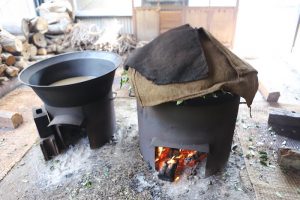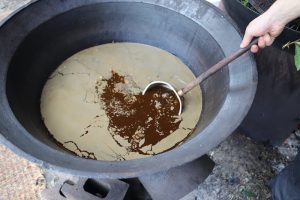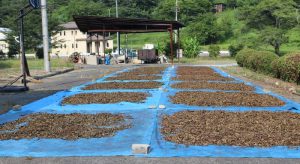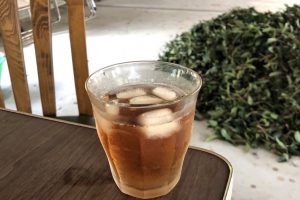MENU
MENU
Tea production area: Mimasaka City, Maniwa City, Niimi City, Takahashi City, Ibara City
Brand name of tea: Mimasaka bancha, Kaita tea, Tomihara tea
Types of tea: Sencha (medium steamed green tea), fukamushicha (deep steamed green tea), hiboshi-bancha (sun-dried bancha), kukicha (stem tea), hojicha (roasted green tea), genmaicha (popped rice green tea), black tea, etc..
Kaita tea
Mimasaka City, being the center for tea cultivation, tea is also cultivated in the surrounding cities with a variety of teas being produced.
Tea cultivation began in Mimasaka City around the middle of the Edo Period. The tea there is called Kaita tea.

Kaita tea at Kobayashi Hokaen (August 2019)
Mimasaka bancha
A traditional hiboshi-bancha has been produced in Mimasaka City from of old. This tea is called Mimasaka bancha. Hiboshi-bancha is sun-dried bancha.
The production method is simple and unique, but being done on the hottest day in the summer makes it hard work.
The tea plant’s branches with leaves on them are plucked and boiled in a large caldron. Then, they are dried in the sun. When it is 1 or 2pm, the hottest time of the day, the broth from the boiled branches and tea leaves is sprinkled over the dried branches and leaves. They dry immediately after the broth is sprinkled over them. Thus, the broth has to be sprinkled over all of the branches and leaves evenly and repeatedly.
When the leaves are completely dried, they are then removed from the branches.

Boiling the branches with leaves at Kobayashi Hokaen (August 2019)

Broth made from boiling branches with leaves at Kobayashi Hokaen (August 2019)

Drying the branches and the leaves at Kobayashi Hokaen (August 2019)
Mimasaka bancha has a mild taste with a little sourness making it the perfect drink for a lot of consumption in a hot season. CHAMART recommends blending Mimasaka bancha with a sweet fermented milk drink or as a milk tea with black pepper.

Mimasaka bancha at Kobayashi Hokaen (August 2019)
Bancha (番茶・晩茶):
Originally bancha means coarse tea in contrast with sencha (medium-steamed green tea). Sencha is produced with new tender tea leaves which plucked in the first tea season in Japan. Bancha is produced with matured hard tea leaves and stems plucked in the late season of the first tea season or in autumn. Shuto bancha means steamed green tea produced with tea leaves plucked in the autumn and early winter.
Additionally, bancha is used for the local special tea, such as Sado bancha of Nigata Prefecture, Mimasaka bancha of Okayama Prefecture, Awa bancha of Tokushima Prefecture, Kyo bancha of Kyoto Prefecture, etc., but each producing method is different.
Tea related facilities:
小林芳香園・お茶の芳香園 https://ocha-mimasaka.com
栄西禅師生誕地
たびおか-旅岡山・吉備の国- https://tabioka.com
栄西禅師生誕地 https://tabioka.com/eisai-zenshi-birthplace/
Ceramic and pottery art: Bizen ware
Reference:
松下智 (平成3年) 日本名茶紀行 (初版) 雄山閣出版
高野實・谷本陽蔵・富田勲・中川致之・岩浅潔・寺本益英・山田新市 (2005) 緑茶の事典 (改訂3版) 柴田書店
大森正司、阿南豊正、伊勢村護、加藤みゆき、滝口明子、中村羊一郎編(2017) 茶の事典 初版第一刷 朝倉書店
お茶の芳香園 http://www.ocha-mimasaka.com
*When visiting the shops and facilities introduced in this article, please check the business hours on their website, etc. before visiting.
*The information provided on this site may be updated. If you find any information in this article that is incorrect, new, or incomplete, please contact CHAMART.
*The site does not describe all “Teas of Japan” or all “Teas of the World”. Additionally, each article expresses the writer’s personal experience and feelings.